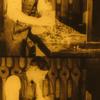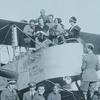Saved from obscurity
The results of reordering and development of historical films from the Caproni Collection

The results of the reorganisation and development of the Caproni historical film collection will be presented on the morning of Monday, October 10, at the Conference Hall of Fondazione Caritro in Trento’s Via Calepina. The Caproni collection, the oldest in the aviation world, started in the early years of the twentieth century when Trentino’s Gianni Caproni took his first steps in aviation. Since 2012 it has been a valuable source of the Trento Province’s public heritage.
The Gianni Caproni Museum of Aeronautics has launched a two-year project to preserve and develop many of the historical films in their collection. The museum is a regional branch of the MUSE Science Museum and is supported by the Fondazione Cassa di Risparmio di Trento e Rovereto. It also collaborates with the Soprintendenza per i Beni Culturali della Provincia Autonoma di Trento and the Fondazione Museo Storico del Trentino.
Consisting of about 190 films and covering a time span between the early twentieth century and 1985, a part of the collection reconstructs the industrial history of the Caproni brand, including the testing of new aircraft and visits to the establishment by the political and military authorities of the era. For the project the films were identified, digitally converted and inventoried in a new database, effectively developing and releasing to the public a rich heritage of aviation films, photographs, literature and archives – all overseen by the Provincia Autonoma di Trento and the Gianni Caproni Museum of Aeronautics.
As a first step, a preliminary survey of the materials was carried out to gather the main data of the films, which was written on a special descriptive card. Then, their state of preservation was evaluated before restoration and conversion procedures were agreed upon with the Soprintendenza per i Beni Culturali della Provincia Autonoma di Trento.
In addition to a preliminary surface cleaning and replacing damaged joints, preservation work included repairing tears in the plastic support, the insertion of protection buffers at the start and end of each reel, and the replacement of the most damaged boxes.
All work, accompanied by photographic documentation and restoration notes, was performed with techniques and products which are specific to the field of preserving and restoring film heritage and implemented by a professional restorer. The most delicate preservation and the digital conversion were conducted by laboratory technicians from La Camera Ottica in Gorizia using professional film scanners and procedures widely accepted by the scientific community in the field of preserving and digitally converting films. High definition master and storage copies were made of each film as well as consultation copies.
For more information on the morning programme and list of speakers click here.
Source: www.trentinograndeguerra.it
Costs:
Free admission, booking is recommended: tel.0461 944888, or: museo.caproni@muse.it










